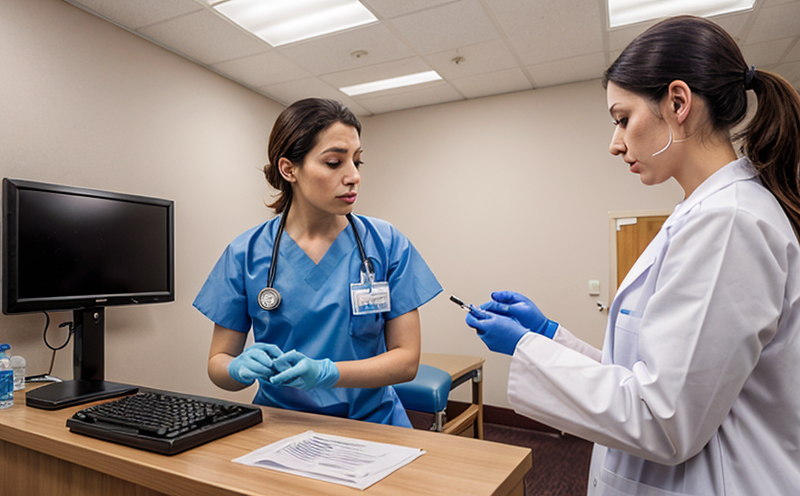Microcystin Residue Testing in Aquaculture Systems
The growing global demand for fish and shellfish has led to a significant expansion of aquaculture systems. However, these systems are not immune to the presence of harmful toxins such as microcystins. Microcystins are hepatotoxins produced by cyanobacteria that can contaminate water supplies used in aquaculture operations.
These toxins pose serious health risks to both aquatic life and human consumers. Given their persistence and bioaccumulation potential, strict regulations have been established worldwide to monitor and limit microcystin levels in food products derived from these systems. This service offers comprehensive testing for residual microcystins, ensuring compliance with international standards such as ISO 21890 and EU regulations.
The process involves the collection of water samples from various points within the aquaculture facility. Samples are then analyzed using advanced liquid chromatography coupled with mass spectrometry (LC-MS). This technique ensures high sensitivity and specificity, enabling accurate quantification down to parts per trillion levels.
Our laboratory adheres strictly to ISO/IEC 17025 accreditation standards, ensuring that all results are reliable and repeatable. The testing procedure includes thorough sample preparation, which involves filtration, concentration, and clean-up steps tailored specifically for microcystin analysis. Once processed, samples undergo rigorous validation procedures before being analyzed by our experienced technical staff.
The test results provide valuable insights into the safety of products derived from these aquaculture systems. They can help quality managers make informed decisions about process improvements or corrective actions needed to reduce contamination risks further downstream in the supply chain.
In addition, this information is crucial for compliance officers responsible for ensuring adherence to regulatory requirements governing food safety and environmental protection. By providing accurate data on microcystin residues, we enable R&D engineers to develop safer processes and formulations that minimize exposure to these harmful substances.
Why It Matters
The presence of microcystins in aquaculture systems can have severe implications for both the environment and human health. For instance, excessive concentrations of these toxins may lead to fish deaths, reduced growth rates, and reproductive failure among affected populations.
From a consumer perspective, ingestion of contaminated seafood could result in acute poisoning symptoms including nausea, vomiting, diarrhea, and even liver damage over time if repeated exposure occurs. The World Health Organization (WHO) has set an acceptable daily intake level for microcystins at 1 μg/kg body weight per day.
Therefore, regular monitoring of microcystin levels is essential to protect public health while supporting sustainable aquaculture practices. Our testing service plays a critical role in maintaining the integrity and safety of aquatic products reaching consumers' tables worldwide.
Benefits
- Ensures Compliance: We help clients meet stringent regulatory requirements by providing reliable test results that comply with international standards like ISO 21890.
- Promotes Safety: By identifying and quantifying microcystin residues early in the production process, our service contributes to safer seafood products for consumption.
- Supports Sustainability: Early detection of contamination allows aquaculture operators to implement corrective measures promptly, thereby promoting environmentally responsible practices.
In addition to these direct benefits, this testing also supports better resource management by helping stakeholders understand the dynamics within their systems more clearly. This knowledge can be leveraged to optimize operations further down the line, leading to improved efficiency and reduced waste generation.
Why Choose This Test
Selecting our microcystin residue testing service ensures that you receive top-tier analytical capabilities supported by experienced professionals dedicated to delivering precise results every time. Here are several key reasons why choosing us makes sense:
- Accurate and Reliable Results: Leveraging cutting-edge LC-MS technology, we deliver highly accurate quantification of microcystins down to trace levels.
- Comprehensive Reporting: Our detailed reports provide not only the quantitative results but also interpretative insights that guide informed decision-making processes.
- Dedicated Expertise: Our team comprises experts with extensive experience in aquatic biotoxin analysis, ensuring you receive personalized attention tailored to your unique needs.
- Frequent Monitoring: Regular testing helps maintain constant vigilance over potential contamination risks throughout the entire production cycle.
We understand that maintaining high standards of food safety and environmental stewardship is paramount in today's competitive market. By partnering with us, you gain access to a robust network of resources designed specifically to meet your unique challenges head-on.





